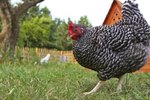
Raising peafowl chicks is not dissimilar to raising chickens. If you have the peahen, she’ll take care of her brood; all you really need to do is provide suitable food and keep the housing clean. If you decide to raise the chicks yourself, you have more work to do, but the birds will bond more strongly with you.
Housing
Basic housing consists of a sheltered house attached to a large pen. While the birds remain small, a chicken coop and run would do but they’ll need more-spacious accommodation as they grow. Eventually, you can allow them to free-range, provided your neighbors don’t object. Mature peafowl are large and aggressive enough that most wild carnivores won’t consider them as snacks. Keep the peafowl in a secure enclosure until they are at least 3 or 4 months old. The enclosure has two purposes: to protect them from predators while they are small and to ensure they have a good idea of their home range.
Heating
Keep the chicks in a brooder to start with if they are very young -- less than a month old. Despite the size differences, a broody hen could hatch peafowl eggs and raise the chicks if this option is available. Install a heater in the housing for older chicks. Without their mother, they need another source of warmth; even adults need extra heat in winter.
Diet
Provide a shallow bowl or saucer for food. Peafowl chicks get assistance from their mother to start with, without it they're not great at finding and taking food. Ensure the bowl is shallow and low enough that the chicks don’t have to stretch or hop to access the food. Don’t forget a waterer.
Feed the chicks high-protein game bird starter, preferably one specifically for peafowl, until they are about 3 months old, supplementing with green, leafy vegetables such as cabbage, dark lettuce and spinach. After that, gradually change their diet to an adult one of pellets.
Don’t feed your pets anything too fatty or salty. Peafowl are omnivores; they like all the treats chickens do, including dog food, fruit, healthy table scraps and worms from the garden. The diet should consist primarily of pellets.
Care
Shovel droppings from the housing daily; go for a full clean once a week. Bird waste is rich in nutrients and safe for home composting, so use it in your garden. Spend as much time as you can handling the chicks if you want pet peafowl instead of semi-wild birds.
Considerations
You may need to worm peafowl chicks or deal with other parasites, though these are more of a problem for large flocks with little space. Consult a vet who specializes in game birds and/or poultry for advice.
If you want only peahens or just one peacock and a couple of peahens, bear in mind that small chicks are literally impossible to sex yourself. Peafowl chicks of less than a month old can be sexed only via a genetic test carried out by a vet -- they can’t be sexed by checking the vents like other poultry because the organs are too deep inside. Older ones show differences in plumage.
Warnings
Peacocks are extremely noisy, and not in a melodious way. If your neighbors wouldn’t tolerate a rooster, they certainly won’t appreciate a peacock. Peahens are a little quieter, but they can still be pretty vocal. Before rushing to adopt peafowl chicks, ensure that your neighbors won’t mind and you are not breaking any local regulations.
These birds are large, and they live for a long time -- at least 20 years, sometimes twice that -- making them a long-term commitment. They're unsuitable if you don't have plenty of space. They need either an enormous enclosed and covered area or to be free-range, which again involves checking with your neighbors. Not everybody would be delighted to find a peacock rooting through their prize flowers.
References
Photo Credits
-
sarah mavro/iStock/Getty Images
Writer Bio
Judith Willson has been writing since 2009, specializing in environmental and scientific topics. She has written content for school websites and worked for a Glasgow newspaper. Willson has a Master of Arts in English from the University of Aberdeen, Scotland.


